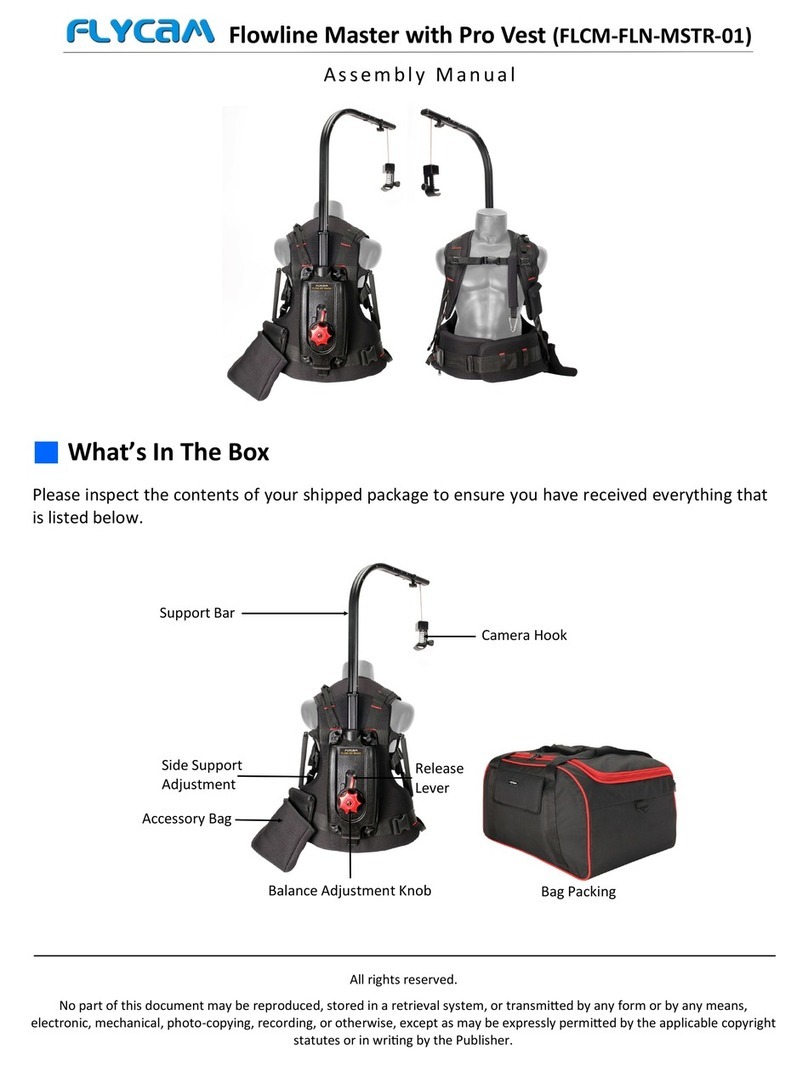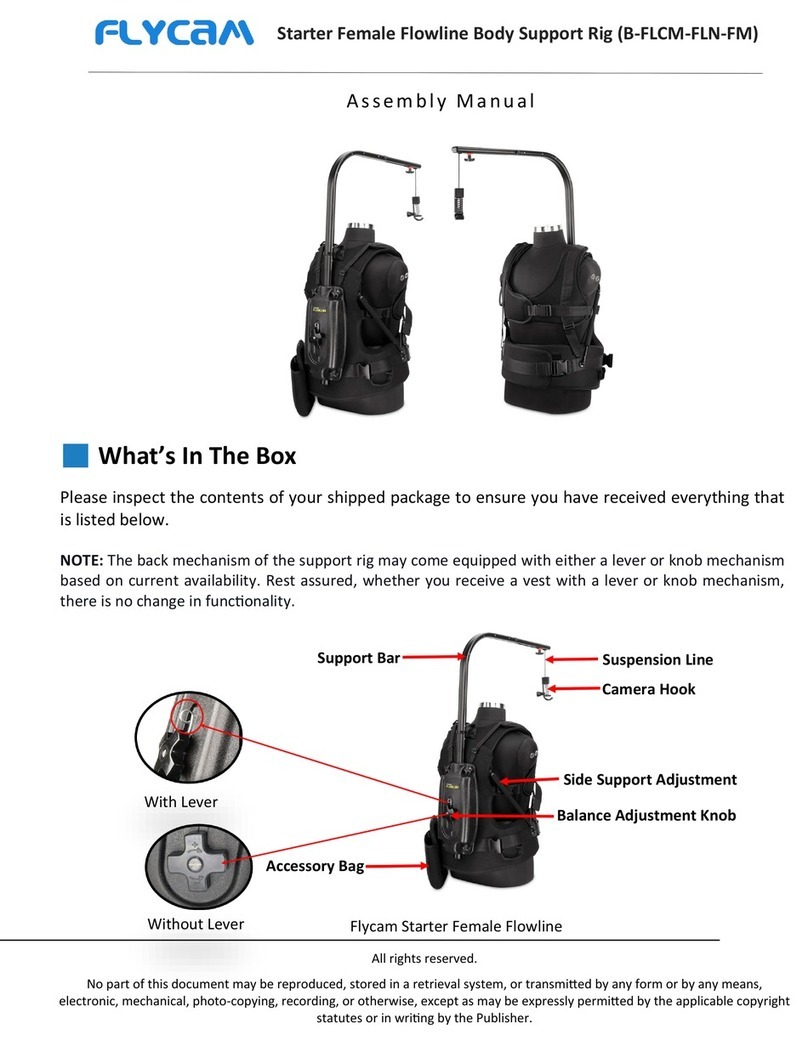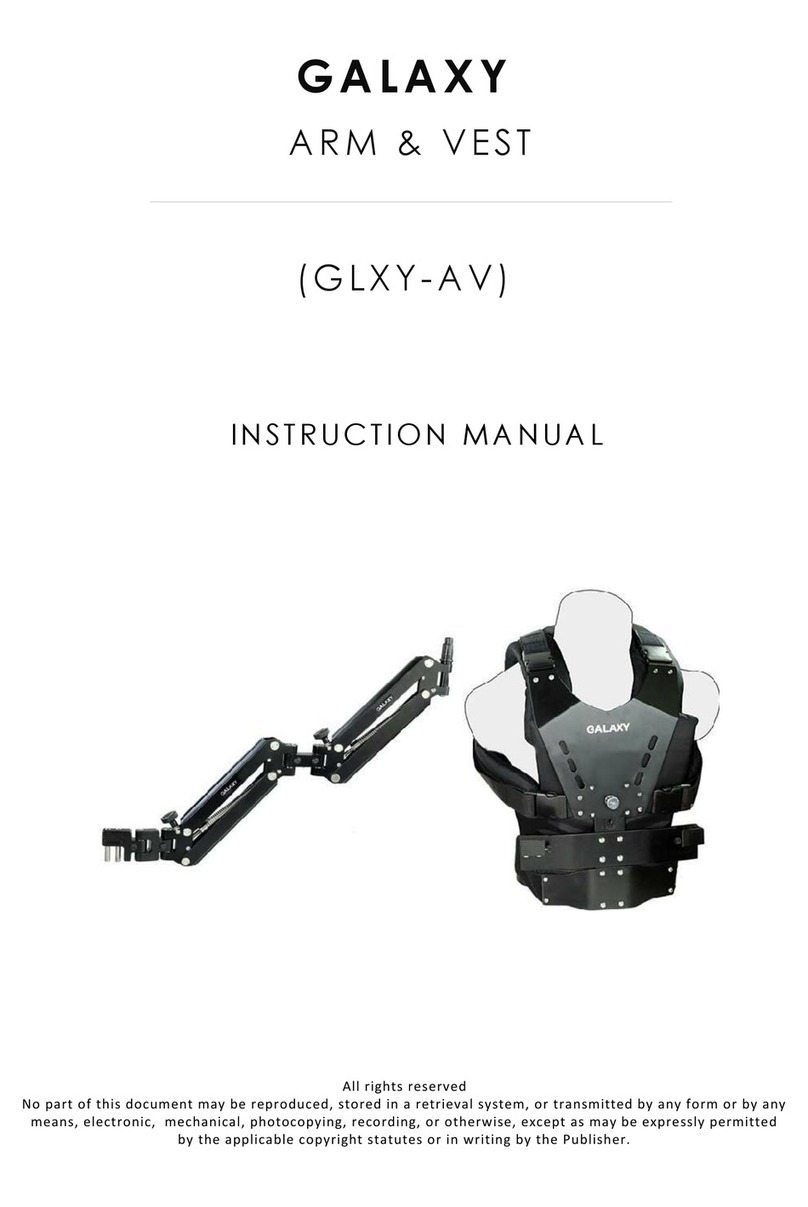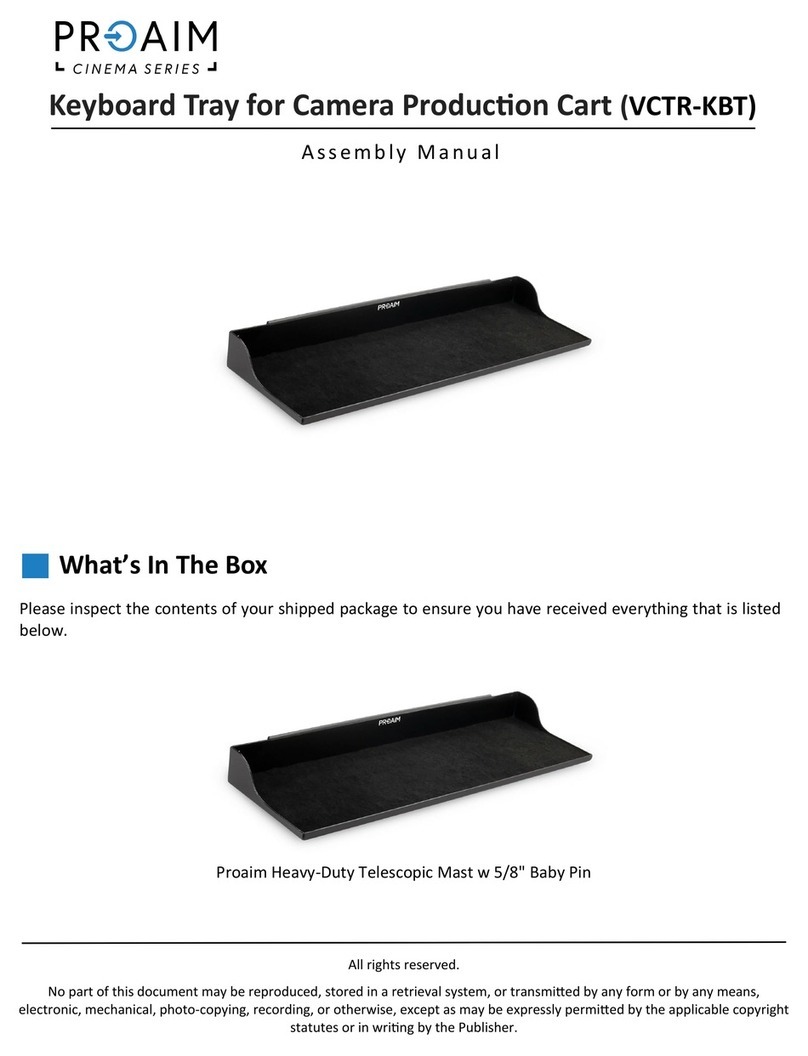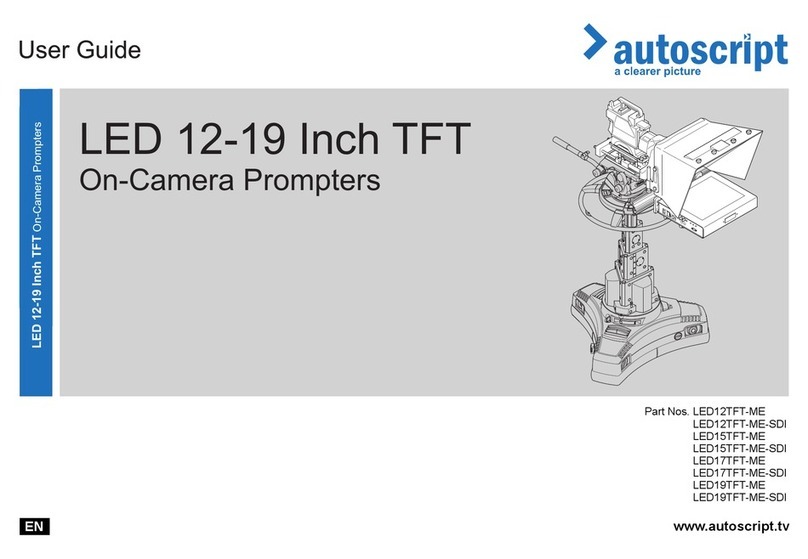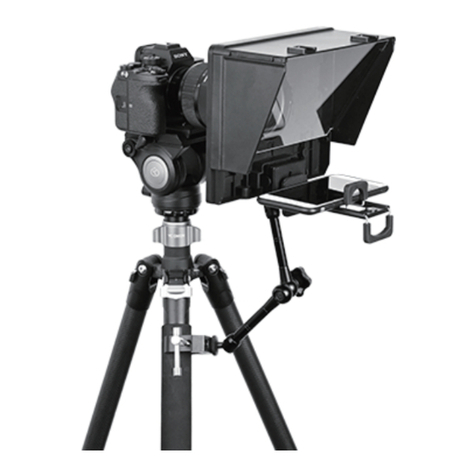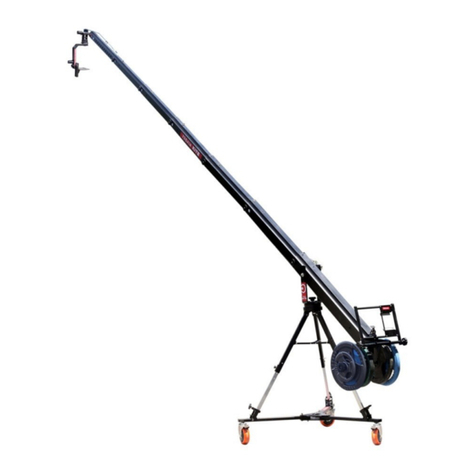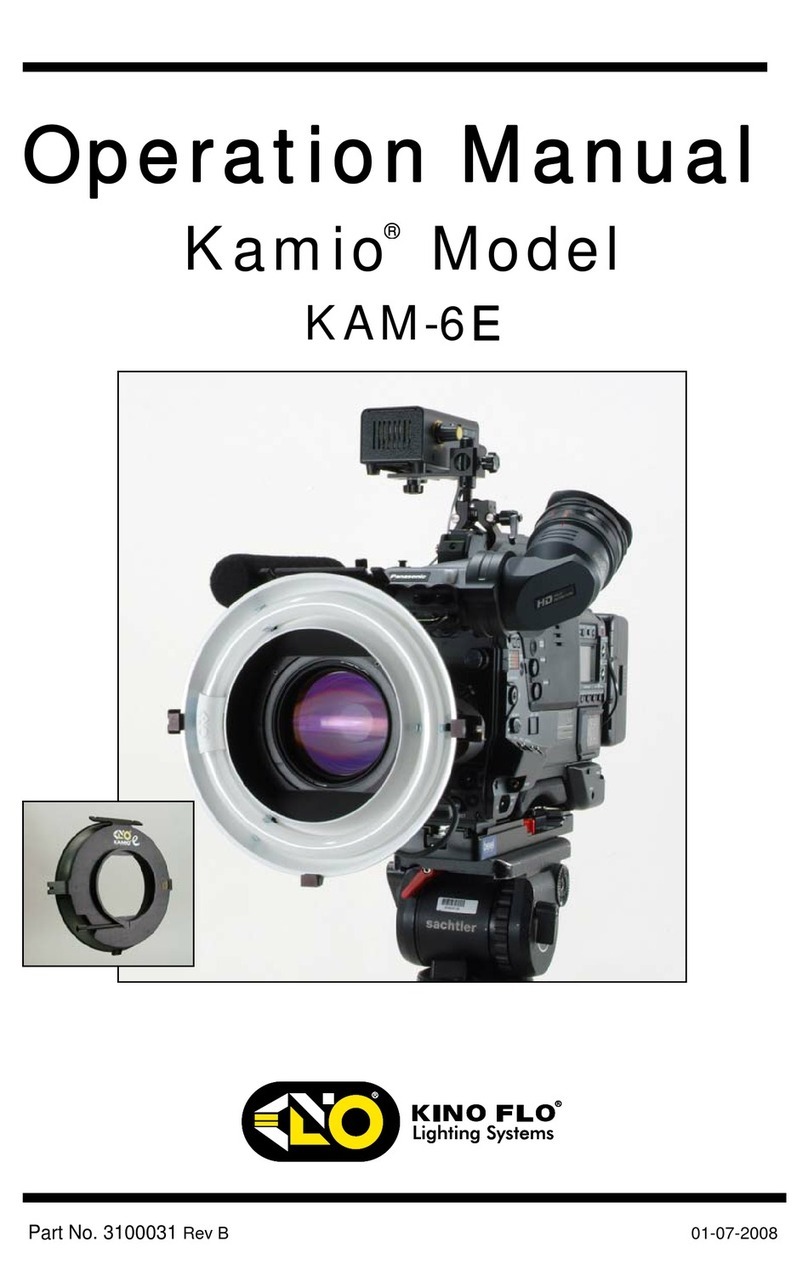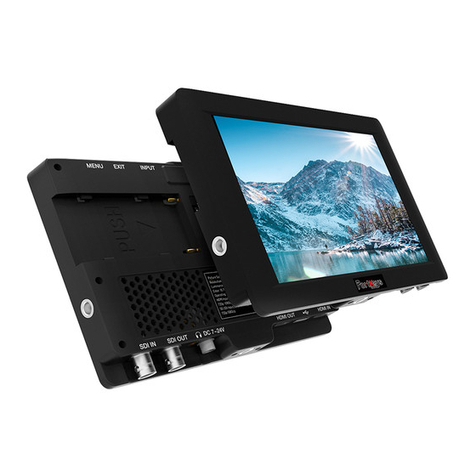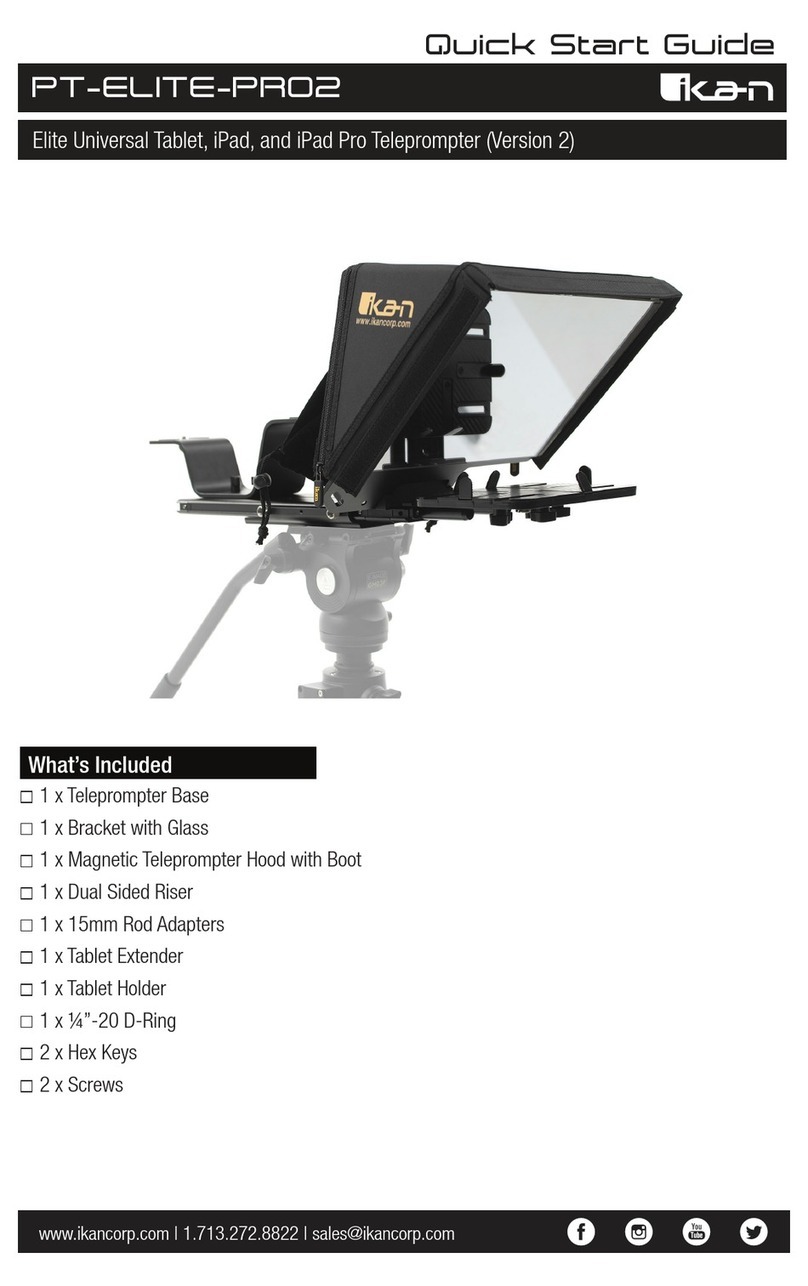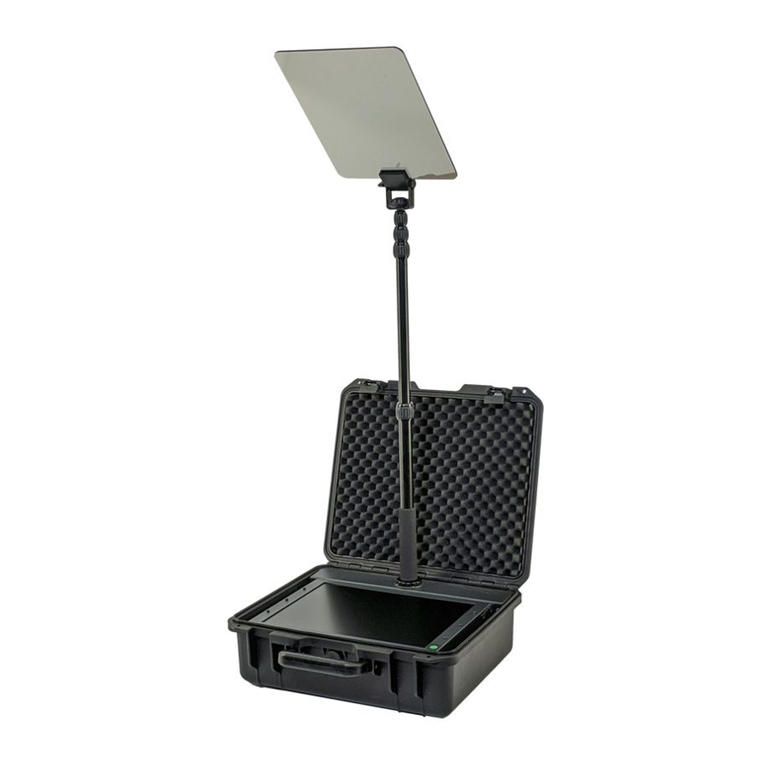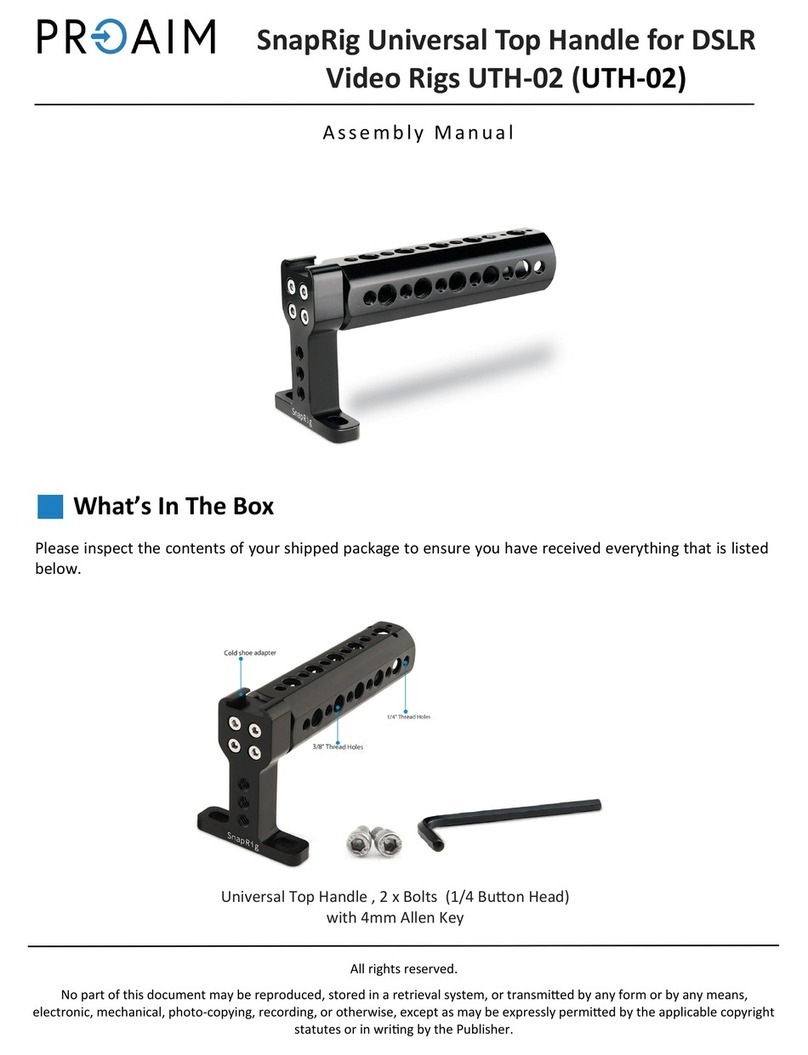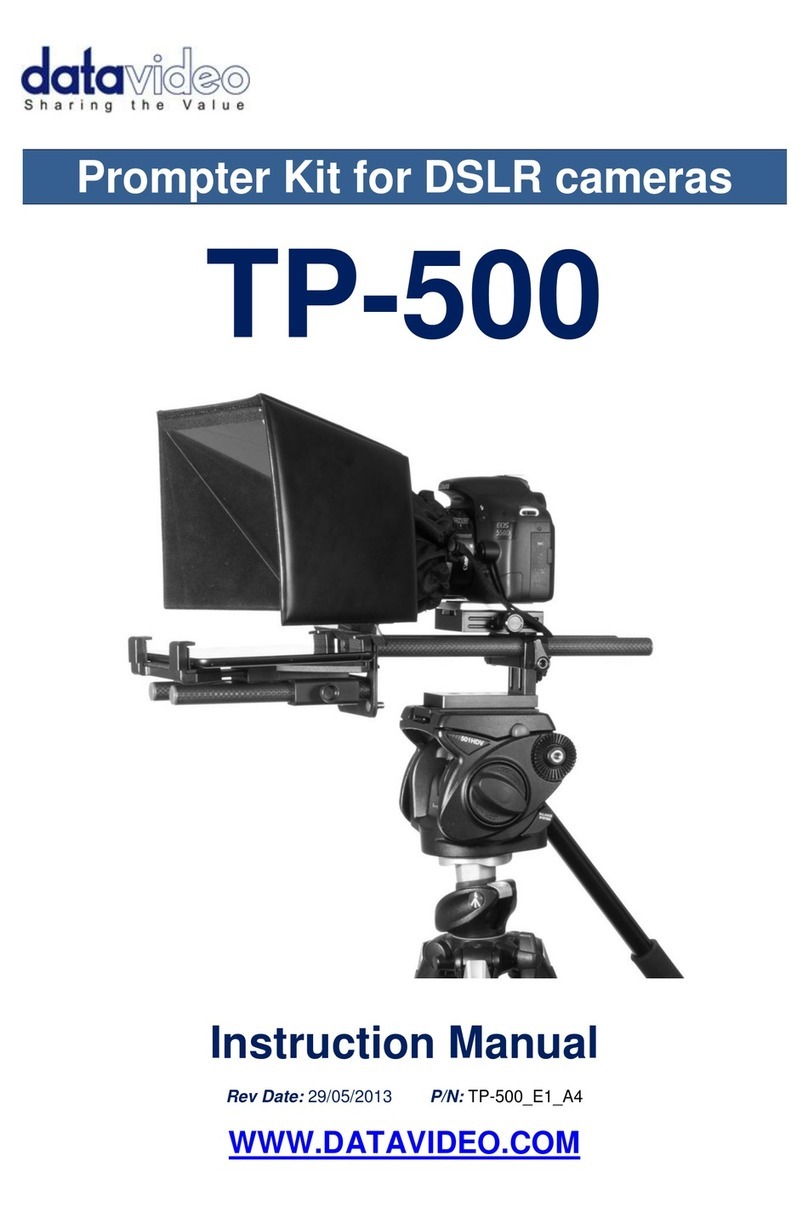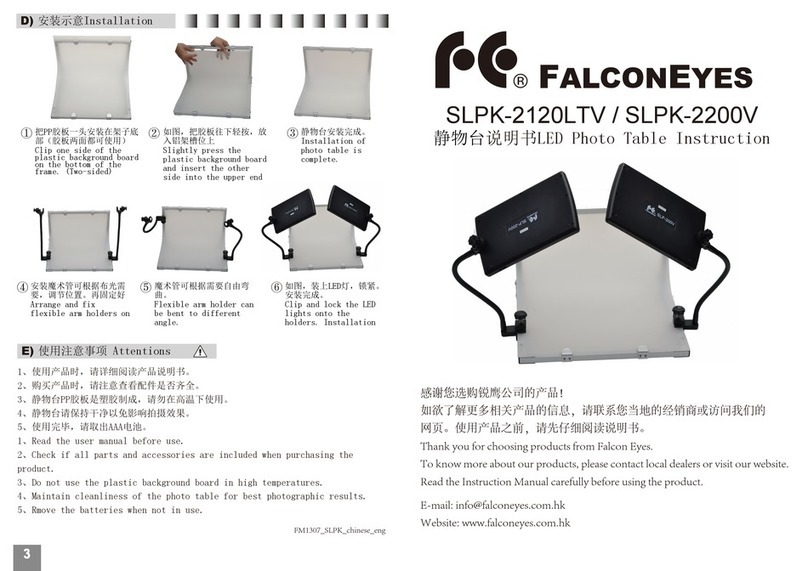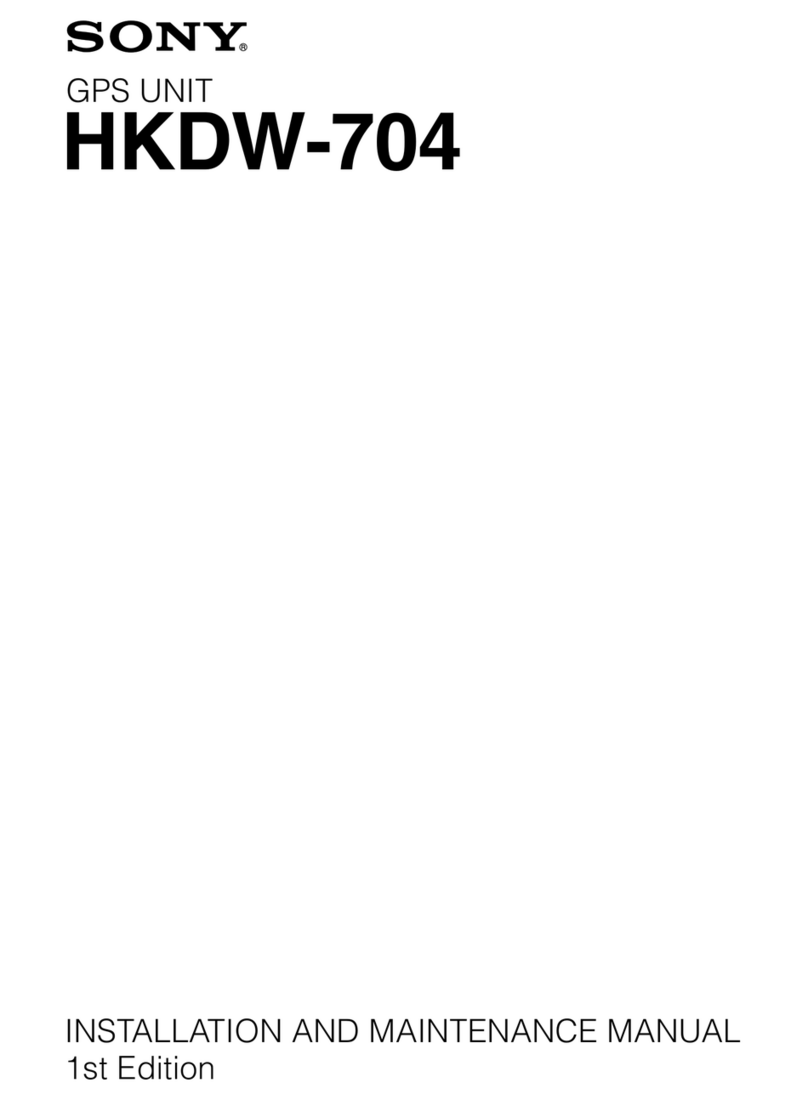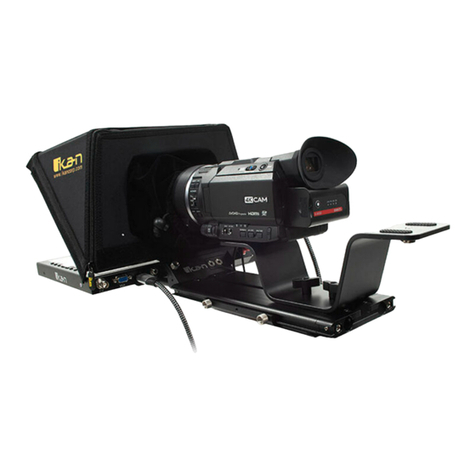Flycam FLCM-DN-ABQ User manual

1
Please inspect the contents of your shipped package to ensure you have received everything that is listed
below.
DSLR Nano Handheld Camera Stabilizer Brace
Support (FLCM-DN-ABQ)
Assembly Manua l
All rights reserved.
No part of this document may be reproduced, stored in a retrieval system, or transmied by any form or by any means,
electronic, mechanical, photo-copying, recording, or otherwise, except as may be expressly permied by the applicable copyright
statutes or in wring by the Publisher.
What’s In The Box
Base Plaorm with 16 weight discs
Head, Mid & Boom Plate
1 x washer
V-shaped adapter
Quick Release
1 x Plasc screw driver
1 x L-Type Allen key (size-3mm)
2 x knob
Camera Bolts
Size - 1/4”, 3/8”
Central Post
2 x Allen bolts

2
Features
Central Post
Quick Release
Head, Mid & Boom Plate
Base Plaorm with 16 weight discs
Head Assembly
Boom Plate
Head Plate Mid Plate

3
Handheld Steadycam with Base Plaorm Setup
• Remove the cap from the middle of the base
plaorm, and you will see 1/4 thread located
in the center, as shown in the image.
• Remove the bolts on either side of the head
plaorm. Mount the head plate to the center
post.
• Insert both the bolts by matching the threads
of the plate to the center post, and then
tighten them using the Allen key.
The slots located on the Head Plate and the Boom Plate allows you to easily adjust X & Y Axis for perfect
balance. Place the assembly in line with center of stabilizer post and ghten the side adjusters, as shown.
• Loosen the side knob and then posion it
according to your requirement by sliding it.
Head Plate Y adjustment
Head Plate X adjustment
• Aach the extended part of the post via
threaded insert at the boom to the 1/4
screw present on the expandable base
plaorm.

4
• Remove all the knobs of the head plate by
loosening them.
• Remove the head plate from the 3-piece head
assembly in preparaon to aach it to your
camera.
• Insert the bolt into the center hole of the top
head plate, as shown in the image.
NOTE: You can mount the camera onto any of
the provided threads on the head plate,
according to your requirement.
• Attach the plate to the bottom of the camera
(Not Included), and then properly tighten it
using the screw driver.
• Mount the camera (Not Included) by sliding it
on the mid plate.
• Tighten the provided knob to secure the top
camera plate with the mid plate.

5
• Remove the Allen bolt from the bottom of
the head, mid & the bottom plate by
loosening it using the Allen key.
• Similarly, remove the second bolt of the plate
as well.
• Tighten the plate using both the side knobs.
NOTE: If you wish to by pass the quick release
plate, the camera (Not Included) can be directly
attached to the Head Plate by using following
assembly sequence (without quick release
plate).
Head Plate with Quick Release Adapter
• Loosen and remove the Allen bolt on the
boom of the quick release adapter and
aach the adapter to the head plate.
• Properly re-tighten the bolts by matching the
center hole of the quick release adapter and
the top plate.

6
• Align the plate to the middle plate and secure
the head plate and the middle plate with the
help of four knobs.
• Remove the plate by pulling the lock lever of
the quick release adapter.
• Now aach the quick release adapter to the
boom of the camera (Not Included) and
ghten the bolts using the screw driver.
• After attaching, secure the assembly by
locking it with the provided lock lever of the
quick release.
• Place the quick release adapter and the top
plate by sliding them onto the middle plate.
• DSLR Nano Handheld Camera Stabilizer setup
is now ready to use.

7
NOTE: When adding weight in the cups, use the
supplied foam spacers as silencers to prevent
metal to metal washer noise.
Horizontal adjustment on the base plaorm is
made by loosening the retaining screws and
moving the mounted cups closer to or further
away from the stalk and then reghtening. You
will probably need to adjust and re adjust the
horizontal posion to achieve opmum
performance/ personal preference.
Adding Weight Sand Posioning for Proper Balance
Connuing the assembly and balance requirements to make your FLYCAM DSLR Nano fully funconal you
will note that the base plaorm has a provision to mount the balance weights in their cups via a slot found
on both sides of the post.
The purpose of the counter weight system is to match the low end of the stabilizer to the weight of the
camera and accessories at the high/top end with the gimbaled handle as the pivot point in between. The
heavier the camera and accessories, the more weights are required to achieve proper balance. Generally as
you add weight to one side of the central post, an equal amount has to be added to the other side to
maintain horizontal balance. However if you are using an oset conguraon such as a ip out viewnder or
o center accessories, extra weights might be needed on the opposite side of the post to counter act and
maintain proper balance.
Total weight xed to the base plaorm should be equal to the weight of your camera plus the head and any
accessories.
Balancing Your Flycam Handled Stabilizer
Vercal stalk Adjustment
The up and down (vercal) posion of the
telescopic central post is adjusted by loosening
the control located at the base, raising or
lowering the stalk to the desired locaon and
then reghtening the vercal control.
Do not over-ghten this control.
Before beginning the balancing process check the following
• Camera is securely aached to head plate.
• Lens cap has been removed and secured.
• Telescoping clamp has been ghtened.
• Weight discs are added successfully.
• All screws are ghtened securely.
• Baery, all accessories and cables should be secured.

8
Balancing The Horizontal Axis
When your FLYCAM DSLR Nano is properly assembled, you can start the test and setup of the horizontal
balance. Horizontal balance allows the camera to remain level during operaon with the Central Post in a
vercal posion unless o axis framing is desired. When tesng for horizontal balance start from a at and
level surface like a table. This will allow the FLYCAM DSLR Nano to hang freely as you hold it. If your FLYCAM
DSLR Nano is correctly balanced on its horizontal axis, then it will be both level & upright, with the Central
Post in a perfect vercal posion.
Warning: If you do not have enough weight on the Base Plaorm the enre Flycam could ip upside down.
Should this movement start to happen be ready to catch the stalk before a complete 180 occurs. This type of
unwanted movement requires more weight to be added to the base with addional weight discs.
Another way to accomplish horizontal balance is to move the center of gravity of the camera by re-bolng
the camera to a dierent area of the Head and Mid Plate, either front to back or side to side.
Should the FLYCAM DSLR Nano be front heavy, loosen the screws on the sides of the Head Plate and gently
slide the Head Plate back unl opmum balance is achieved. Tilng to the back means the load is tail heavy
requiring the plate to be adjusted forward on the head.
Always secure the screws aer any adjustments.
If you cannot achieve front to back axis balance with this method, then try remounng your camera to a
dierent hole on the Head Plate. Having achieved horizontal balance for the front to back axis, ghten the
screws on the Head Plate. If the FLYCAM DSLR Nano leans to the right, then loosen the screws on the
boom of the Boom Plate and then gently slide the Mid Plate to the le. If it leans to the le from the
operator’s point of view, then adjust the Mid Plate to the right. A bit at a me unl balance is achieved.
Secure all parts aer adjustments are made.
It may be necessary to recongure front to back adjustments once correct side-to-side ne-tuning has been
accomplished. Another opon to consider is moving the Counter Weight cups back & forth on the Base
Plaorm by sliding them either closer to or further away from the Center Post via the built in base slots.
Make sure to ghten the cups down should you move them.
Balancing The Vercal Axis
The sled should be ed up to the docking adapter of your stand or similar so that you can start the fore & a
balancing adjustments by centering the camcorder over the central post. To do this
• Loosen the side screws of the head plate and the boom screws of the boom plate.
Look at the FLYCAM DSLR Nano from the side. If the camcorder lens is pped up or down, move the
camcorder forward or backwards unl the center of balance is situated over the central post.
• Then, look at the FLYCAM DSLR Nano from the front. If the post is not vercal, adjust the boom plate
unl the center post is vercal.
• You can also adjust the weight cups closer to & further away from the sled as per the requirement ll the
post is straight up and down.
• The stability of the FLYCAM DSLR Nano depends on it being slightly boom heavy. If it is top heavy, it will
lt more. If boom heavy, it will be sluggish and hard to aim.

9
Slightly boom heavy, it will be both stable and easier to control.
Check the vercal balance by using this drop me test
• Make sure that everything is ght and posion yourself behind the stand.
• Grasp the center post near the base and move the center post from vercal to horizontal.
• Hold it there. Be sure that it will not hit the stand when you drop the center post and put your free hand
to catch the center post when it drops.
• Count how many seconds it will take to fall to vercal. Try using a stopwatch.
• If the drop me is less then 2 seconds, it is too boom heavy. You need to move the boom mass closer
to the post.
• If the drop me is more than two seconds, it is top heavy.
A drop Time of 2 - 2.5 Seconds is preferred.
NOTE: Recheck the balance by looking at the sled. If necessary, use the side screws and the boom plate
screws to make required adjustments.
Balancing Review
Proper system balance can only be achieved once your camera is set up with the appropriate accessories
ready for shoong. This means baeries, lenses, media cards, LCD viewnder/ monitor, quick release plate,
on-cam lights, and all the gear you will use for your recording session.
• Remove the top plate of the Flycam and line up your camera so that its center of gravity is as close to the
center of the plate as possible (basically hold the camera in your hand unl it feels balanced both le and
right as well as forward and back).
• Find the hole in the plate that is as close to the threaded tripod mount on your camera as possible (while
you are sll holding your camera's center of gravity to the center of the plate). Aach your camera (or
quick release mount if you have one). Tighten it down so it.

10
• This will allow the “yoke” part of the gimbal
to rotate without hing your hand or
knuckles
• won't accidentally rotate.
• Re-aach the top plate to the Flycam. Center it, but don't worry about geng it absolutely perfect yet.
• Remove most of the weights from the Base Plaorm, but leave one on each side.
• Insert the center post as far as it will go and ghten so it won't slide out.
• Hold the handle normally and turn the FLYCAM DSLR Nano so that it is horizontal to the ground. Let go of
the stalk while keeping a rm grip on the handle and count how long it takes to return to vercal again.
You should be able to count a good, "One-one thousand, two-one thousand", before it rights itself. With
only two lile weights it might take considerably longer.
• Add one pair of weights at a me and repeat the "horizontal to vercal" test unl it falls at the correct
rate. It will probably not be perfect.
• You'll get one that's too slow and then you'll add a pair and it will fall too fast. When that happens, take
o the last pair of weights that you added.
• Tighten down the weights so they don't slide around.
• To get the count perfect, slightly lower the center post that aaches the Base Plaorm with the weights
unl you get the "one-one thousand, two one thousand" count to the vercal posion.
• Fine-tune the le-right, forward-backward balance. You will have to go back and forth between the two
direcons to get the balance just right. Loosen the screw sets that allow the sled to move le and right.
Adjust the top plate so that it is centered and ghten down the screws like you would a re slowly and
alternang side to side.
• Repeat for "forward-backward" balancing.
• Check to see if your camera is sing level. If not, repeat the necessary steps unl it does.
• Pracce walking/movements ensuring your body moon is not transmied to your hands and then the
Flycam and camera.
HOLDING THE FLYCAM DSLR NANO
When handling your DSLR Nano one hand holds onto the handle while the other is used to gently guide the
camera in the direcon you wish to shoot and frame the shot.
For normal shoong, hold the handle in the middle.
For shots that require framing the camera up, down or sideways, hold the handle rmly at the boom.
MAINTENANCE
Bearing Maintenance
The Main Bearing on your FLYCAM DSLR Nano is aached to the central post about two inches from the top.
It is of metal construcon and parally enclosed by the Bearing assembly. If aer a period of me your
bearings don’t turn smoothly, lubricate with a minimum of light machine oil. Light lubricang oil can also be
used on the Yoke and Handle Bearings. Be sure to keep oil away from your camera, & clean up any over spill.

11
Cleaning
Do not use solvents or harsh cleaners of any kind on your Flycam DSLR Nano. If the unit becomes dirty, use a
damp so cloth or sponge and a mild detergent to gently clean external parts.
Storage
• Should you need to store your FLYCAM DSLR Nano for a long period of me then place the unit upright in
a dry or low to normal humidity area whenever possible. If you are unable to nd this kind of environment
then we suggest you store the unit in an airght plasc container or bag.
• Standing the unit upright is preferred as it alleviates stress on the system.
NOTE: The FLYCAM DSLR Nano doesn’t work under water, nor is it waterproof. Avoid direct exposure to rain,
water spray or any other harsh environment. Also the bearings are not sand/ grit proof and need to be kept
free of these contaminants. Avoid geng dirt or sand in them.
Pracce Makes perfect - Walking the ling
• Pracce this simple exercise to master your
FLYCAM DSLR Nano with professional results.
Using masking or gaers tape, create a cross
mark on a at and even wall. The mark
becomes your framing center. On the oor
leading up to the cross mark, lay a straight
tape line of about 20 feet. Pracce walking
the line, while keeping the cross mark center
framed and in focus. With a bit of eort,
dramac uid like movements will become
second nature and provide producon value
to all your set ups.

12
YOUR FLYCAM DSLR NANO HANDHELD CAMERA STABILIZER
ALL DRESSED UP AND READY TO GO!
(SHOWN WITH OPTIONAL ACCESSORIES)
Warranty: We oer one year warranty for our products from date of purchase. Within this period of me,
we will repair it without charge for labor or parts. Warranty doesn’t cover transportaon costs nor does it
cover a product subjected to misuse or accidental damage. Warranty repairs are subjected to inspecon and
evaluaon by us.
Liability: We are not liable for damage caused by products that we do not supply or from mishandling in
transit, accident, misuse, neglect, lack of care of the product, or service by anyone other than our company.
Contact Us: In case of any kind of dissasfacon, please Contact us immediately and we promise our utmost
support and care unl you use our product.
Table of contents
Other Flycam Professional Video Accessories manuals
